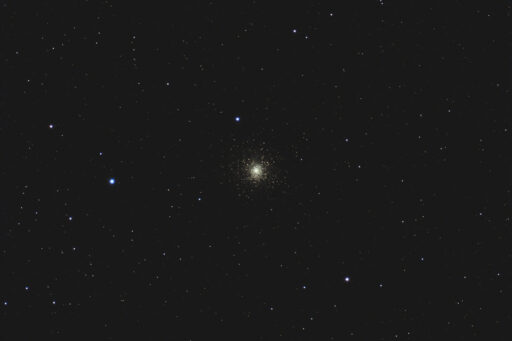
Telescope: Unitron 510 5” f/16 refractor, Atlas EQ-G
Camera: Canon EOS Ra full frame DSLR
Filter: 2” Baader Fringe Killer (Minus Violet)
Guide scope: Williams Optics 50mm Guidescope, ASI290MM, PHD
Exposure: 32x60sec, ISO 1600, saved as RAW
Darks: Internal (Long Exposure Noise Reduction)
Flats: 32×1/125s tee shirt flats taken at dusk
Average Light Pollution: Bortle 8, very poor transparency, haze, smoke, full moon
Lensed Sky Quality Meter: 17.8 mag/arc-sec^2
Stacking: Mean with a 1-sigma clip
White Balance: Nebulosity Automatic
Software: Backyard EOS, Deepsky Stacker, Nebulosity, Photoshop
M15, a bright, condensed globular cluster in a relatively lonely stretch of sky in Pegasus. It is one of the oldest known globular clusters with an estimated age of 13.2 billion years and the first globular cluster found to have a planetary nebula (Pease 1), one of only four planetary nebula associated with a globular cluster. M15 is also one of the most condensed globular cluster and at some point in the distant past it experienced a core collapse that may have heralded the formation of a black hole in its nucleus. This is supported by the fact the M15 is an x-ray source.
This is the first of two images taken to evaluate the performance of Unitron 510 for imaging and the Baader Fringe Killer Filter. This full-frame field is quite remarkable in that it shows a sharp, high contrast image across the entire field with perfect star shapes. There is still just a tad of violet fringing around some of the brighter stars, but it is much reduced as compared to an image of the same field taken without the filter.
M15 is currently well placed rising the east in the early evening and is high in the south at dawn. (Photo credit: John Graham, 7-30-2023)
Recent Comments